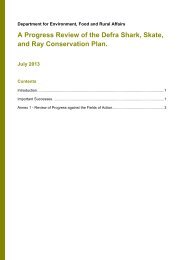A study of Patent Thickets (1.31Mb) - UK Intellectual Property Office
A study of Patent Thickets (1.31Mb) - UK Intellectual Property Office
A study of Patent Thickets (1.31Mb) - UK Intellectual Property Office
Create successful ePaper yourself
Turn your PDF publications into a flip-book with our unique Google optimized e-Paper software.
A Study <strong>of</strong> <strong>Patent</strong> <strong>Thickets</strong> 19<br />
staff relative to the workload. Before the USPTO was able to grant a patent, the invention was<br />
already obsolete, especially in fast growing high technology sectors (Jaffe, 2000).<br />
In order to overcome this problem the U. S. Congress passed a series <strong>of</strong> laws that strengthened<br />
and modernized the patent <strong>of</strong>fice. Most importantly, Congress passed the Federal Court<br />
Improvement Act in 1982. This law created the centralized Court <strong>of</strong> Appeals for the Federal<br />
Circuit (CAFC). The CAFC has exclusive jurisdiction over appeals in cases involving patents and<br />
claims against the federal government in a variety <strong>of</strong> subject matters. This court was created<br />
mainly for two reasons: to bring greater uniformity in patent law enforcement, and to reduce the<br />
case-load crisis in the federal courts <strong>of</strong> appeals (Jaffe, 2000).<br />
In a series <strong>of</strong> studies based partly on practitioner interviews (Hall and Ziedonis, 2001; Ziedonis<br />
and Hall, 2001; Ziedonis, 2004), Hall and Ziedonis show that one consequence <strong>of</strong> the creation<br />
<strong>of</strong> CAFC and the greater willingness <strong>of</strong> that court to grant injunctions was to increase the holdup<br />
threat to defendants in patent litigation and that this led to an increase in defensive patenting<br />
in the semi-conductor industry. The practice <strong>of</strong> “patent portfolio” racing for defensive purposes<br />
soon spread to other parts <strong>of</strong> the ICT industry (Hall, 2005) and to other jurisdictions (Harh<strong>of</strong>f et<br />
al., 2007).<br />
Galasso and Schankerman (2010) <strong>study</strong> how the fragmentation <strong>of</strong> patent rights and the<br />
formation <strong>of</strong> CAFC affected the duration <strong>of</strong> patent disputes during the period 1975-2000, and<br />
thus the speed <strong>of</strong> technology diffusion through licensing. They have two main empirical findings.<br />
First, patent disputes in US district courts are settled more quickly when infringers require<br />
access to fragmented external rights, but this effect is much weaker after the introduction <strong>of</strong> the<br />
CAFC. Secondly, the introduction <strong>of</strong> the CAFC is associated with a direct and large reduction in<br />
the duration <strong>of</strong> disputes, which they attribute to less uncertainty about the outcome if patent<br />
disputes go to trial. This is a beneficial result <strong>of</strong> the formation <strong>of</strong> this court.<br />
However, there is some evidence that patent litigation in the information and communications<br />
technologies as well as in s<strong>of</strong>tware has increased substantially recently (Berneman et al., 2009;<br />
Federal Trade Commission, 2011; Carrier, 2012). The recent report by the FTC (2011) discusses<br />
the economic effects <strong>of</strong> injunctions and the criteria used when deciding on injunctions at great<br />
length. The report proposes that the courts should adhere to the 2006 Supreme Court decision<br />
in eBay v. MercExchange 8 which set out four factors required to obtain a permanent injunction<br />
against a later patent. On the whole these factors should make obtaining an injunction much<br />
harder than previously, as they require US courts to consider the public interest in coming to a<br />
view about injunctions.<br />
In Europe there has recently been a spate <strong>of</strong> court cases related to smartphones, in which firms<br />
have sought to obtain injunctions to delay entry <strong>of</strong> products while appealing to the European<br />
competition authorities to investigate the licensing or not <strong>of</strong> standards essential patents (Carrier,<br />
2012). German courts have been particularly central in these legal cases as they rule quickly<br />
and due a stronger presumption <strong>of</strong> validity built into its bifurcated enforcement system,<br />
preliminary injunctions are more frequently employed. Helmers and McDonagh (2012a), in<br />
contrast, find no evidence for changes in litigation behaviour before the relevant courts in<br />
8 eBay, Inc. v. MercExchange, LLC, 547 U.S. 388, 391 (2006).

















